The new year is a time when we naturally pause and reflect on the prior year to decide what we want to do differently moving forward. We do this in our personal lives almost instinctively, but it’s essential to take stock of what we need to change in our businesses, too.
One of the most important assessments that your business needs to make is how much to budget for marketing in 2020, and how exactly you want to allocate that budget.
Click To Tweet
Marketing is essential to reaching your target audience, to promote new products and services, and to grow your client list. Without it, you’ll struggle to scale your business successfully.
Deciding how much you should budget, of course, can be a challenge in and of itself, let alone deciding how you want to spend it. To help you make these decisions, let’s take a look at how you should determine your digital marketing budget and what exactly you should be budgeting for in 2020.
Book My Free Marketing Consultation
What Is a Marketing Budget?
A marketing budget is how much money you have available to spend on all your marketing efforts, and it should ideally detail how much you’re going to spend on each marketing channel.
The top marketing channels include:
- Business website
- Social media platforms
- Email marketing
- Organic media (like content marketing and SEO)
- Paid ads (like PPC and Google Ads)
- Podcasts
- Word-of-mouth
You may not know exactly what you’ll spend where, but having a basic marketing budget plan is a good place to start. You can always adapt it as the year goes on and you see which platforms are worth investing in, as well as accommodating for any new changes in technology, platform or ad options.
Even if your business’s profit margins aren’t always steady, it’s good to have at least a basis of a plan.
As Peter Drucker is so often quoted as saying:
If you can’t measure it, you can’t improve it.
One study estimated that around 50% of small businesses don't have a marketing plan, likely because 86% of respondents want to focus more on other business activities instead of marketing.
You don’t want to make this mistake for your own business!
Related Content: Content Strategy on a Budget: How to Grow Your Online Presence on a Shoestring
Marketing Budget Breakdown: What You Need to Budget For
Let’s say that you’ve decided you have $10,000 per year to spend on marketing. This might seem like a big number at first, but if you’re not careful, it’ll be gone before Independence Day!
Keep in mind that your marketing budget needs to pay for all of the following:
- Costs associated with running campaigns, like ad spend for PPC campaigns or the payout you give influencers (including industry blogs, if relevant) to post about your products.
- Marketing, advertising and consulting services, including graphic design, copywriting, SEO optimization experts, and strategic development.
- Cost of software used to improve, create or streamline marketing campaigns, like graphic design software, social media scheduling software, and keyword research tools.
- Training for any internal team members (including yourself!) about latest marketing best practices, which may include online courses, subscriptions to reputable publications, conventional classes, workshops or conferences.
Depending on the way your business’s budget is structured, you may also need to factor in paying the employee(s) responsible for managing your marketing campaigns. Even if they work on separate tasks, too, and only spend half their time on the marketing, you might need to factor that into your overall payroll and see how it all impacts your total bottom line.
Learn More: How to Decrease Your Marketing Budget without Hurting Your Business
So, How Much Should You Spend on Marketing in 2020?
“How much should I spend on my marketing budget?” is a highly individualized question, for what it’s worth, and every business will have a different answer.
Some businesses will have much more wiggle room in their budgets than others; those who are just starting out and who have high overhead costs, for example, may struggle to invest a ton of ad spend in expensive PPC campaigns. It’s still important to remember, however, that no businesses can afford not to invest in marketing.
The average marketing budget can vary wildly by industry:
- Some small businesses invest between 1-4% of their annual budget in marketing
- Some medium-sized businesses and larger will opt for closer to 9-12% of their annual budget
A lot depends on your overall overhead costs and the capital available to you.
As a writer who works from home, for example, my overhead is very low; I pay for an assistant, invoicing software, services for an accountant, and credit card fees as my primary expenses. This is nothing compared to businesses shelling out thousands of dollars in storefront leases and shipping fees, so I have more money to invest in marketing than someone with much higher overhead.
A good place to start is to use a free (no need to add to your budget!) marketing budget calculator and see what they recommend. These calculators will typically ask for information about your revenue, your industry, and how aggressive you want to be with your marketing campaigns and give you a rough estimate of where to start.
Check out these marketing calculators (which can make great budget planning tools):
Insivia
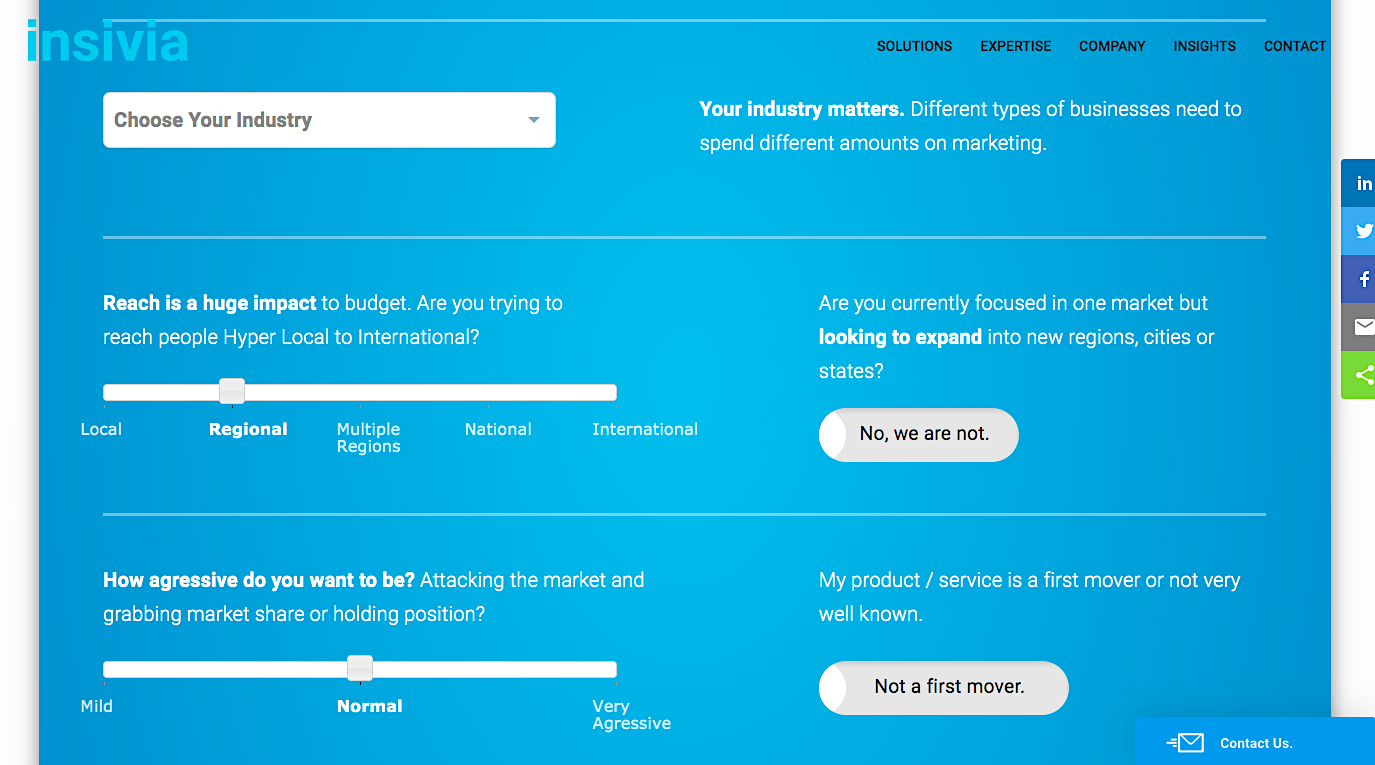
Hook Agency
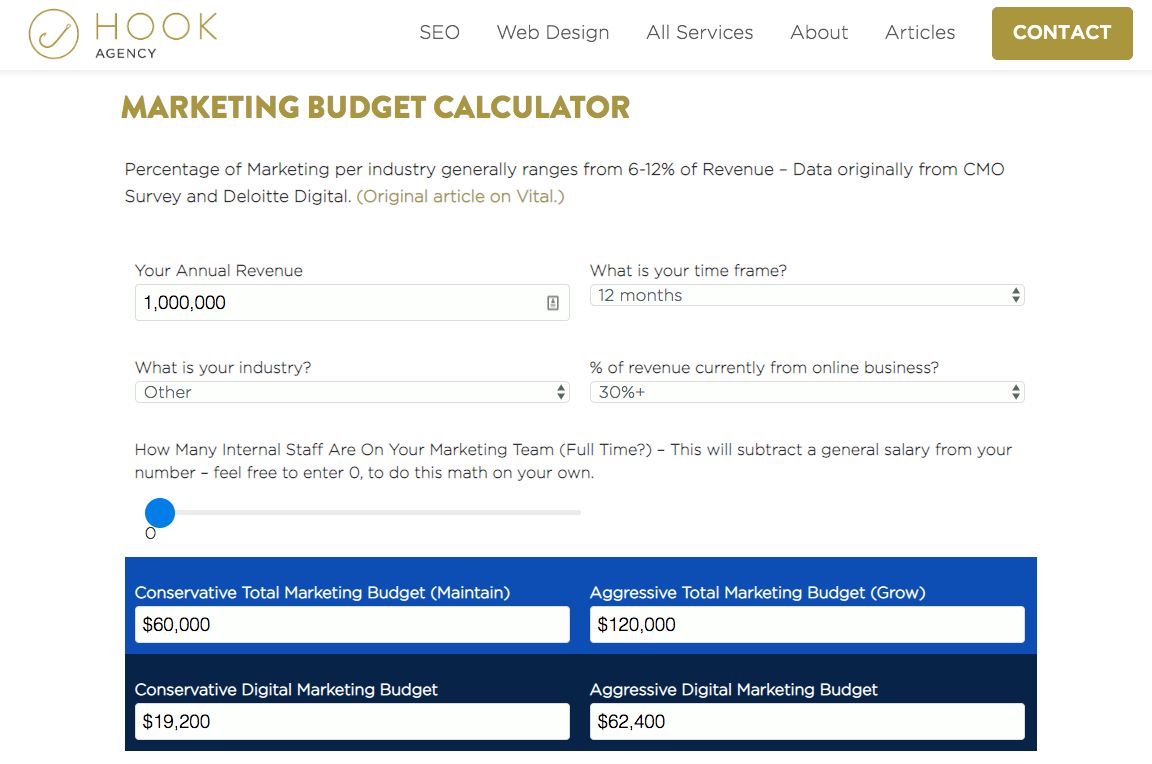
WebStrategies
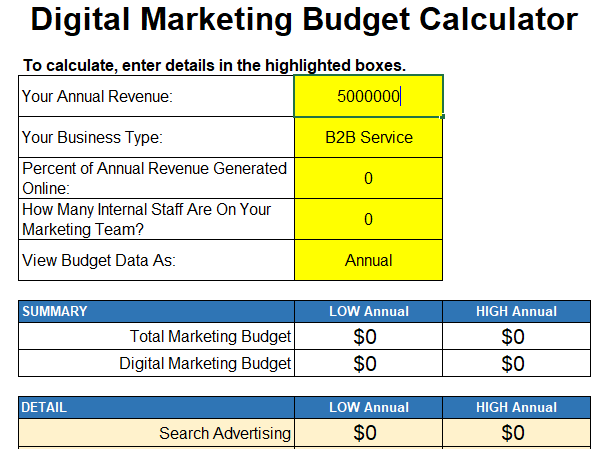
Many of these calculators will include a suggested breakdown of how to divide up the ad spend, though this shouldn’t be followed religiously; different brands will want to prioritize different platforms.
A small business that is just starting out and wants to find customers in a hurry, for example, will likely need to invest more in outbound campaigns like PPC advertising, while one that’s been around longer may choose to invest more in referral programs.
Book My Free Marketing Consultation
Marketing on a Shoestring Budget: The Basics
If you’re seeing these numbers and starting to sweat a little, take a deep breath – there’s no minimum amount that you need to spend on marketing. It’s more than possible to set up low-budget marketing campaigns that are effective and inexpensive at the same time.
While you will typically need to spend something to drive cold traffic quickly, it’s also important to remember that there are plenty of free or cost-effective platforms that you can put more energy into. They may take a little longer to drive results, but they can work well for you.
Free or low-cost options include:
- Social media marketing
- Email marketing
- Content marketing
- Search engine optimization
- Having a strong, branded website
- Asking customers for reviews (which will cost less than an official referral program where you offer financial benefits in exchange for referring customers)
There are also platforms that can benefit you that do require some ad spend, but allow you to control exactly how much you’re spending and on what. Pay-per-click (PPC) campaigns like Google Ads and Facebook Ads are great examples, allowing you to spend as little as you’d like per day and to set a bid cap that dictates the exact cost per action (CPA) you’re willing to pay.
Look at what you can afford to spend, and then divide the budget up accordingly. Remember: while fancy marketing tools are useful, you don’t need all of them.
- Google’s Keyword Planner is free, for example, so you don’t need to pay for fancy SEO keyword research tools if it’s just not in the budget.
- Facebook’s Creator Studio now allows you to create and schedule posts for both Facebook and Instagram, reducing the need of expensive social management software. This can help keep your costs down, too.
Learn More:
How to Allocate Your Marketing Budget in 2020
Every business’s marketing budget breakdown will be different. We’ve all got different budgets, different experience levels, and different business goals. The key is knowing how to determine your marketing budget and how to break it down.
An entrepreneur focused on establishing thought leadership in 2020, for example, may invest more of their budget into research tools that can help them with their own SEO, and potentially a ghostwriter to help them create stronger content. They might also focus on using low-cost ad campaigns that are designed to boost engagement and visibility.
Businesses focused on scaling aggressively, on the other hand, will likely go all in on PPC campaigns. Their ad spend may be higher, because they’re willing to invest a lot in campaigns that help them reach high-intent users actively searching for products or services like theirs. They also might be paying more to be reviewed on industry blogs or to have sponsored posts from trusted influencers.
The first thing you need to do before making any other choices about how to allocate your budget is to look at your non-negotiables.
If you know that you absolutely need to hire a specific consultant to help you develop or assess your campaigns, find out their fees early on. Or maybe you want to use social media scheduling software and the lowest price you can find is $49.99 a month. Factor that into your budget first so that you don’t accidentally leave it out.
Then look at your specific goals, where you think you can best connect with your audience, and what strategies you want to use to accomplish those goals. Typically, things will fall into place as you prioritize certain platforms over others and see what’s most important to you.
Learn from the Best! –> Just Do It: What We Can Learn from Nike’s $39B Marketing Strategy
4 Marketing Budget Mistakes You Don’t Want to Make in 2020
All brands and businesses are marketing on a budget, whether it’s a shoestring budget or one so large that most business owners could only dream of having comparable funds.
But no matter what kind of budget you have, there are a few budgeting mistakes that you’ll want to avoid. Let’s take a close look at each one.
1) Neglecting to Research Before You Start
When it comes to setting up and allocating a budget, you don’t want to go with a “best guess.” You want to do detailed research to make sure that you have a realistic expectation of what everything costs.
You may hear from a good friend, for example, that Google Ads cost around $5 per click and has driven a ton of conversions for their e-commerce floral business. When you actually start creating or running campaigns, however, you come to the unpleasant realization that as a personal injury attorney, this isn’t your reality, and that you’re looking at closer to $100+ per click.
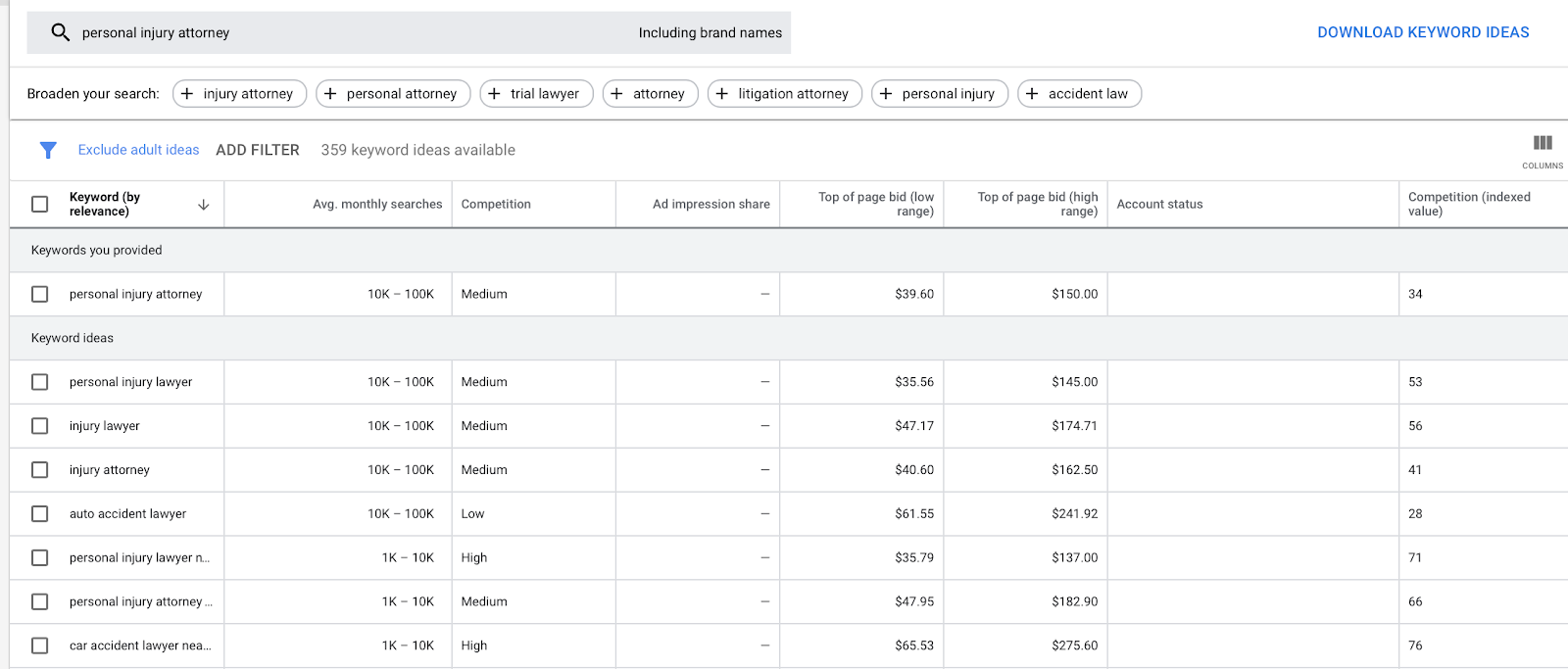
So you need to be prepared.
If you want to work with an agency or a freelancer, get specific quotes related to your project in terms of cost and the volume of work. Look into the CPC averages for the keywords you value most, and make sure that you’re assessing the overall potential effectiveness of each platform.
Related Content: Targeting Branded vs. SEO Keywords: Which Should You Focus On?
2) Getting Stuck and Not Adapting
You aren’t necessarily meant to set one strict marketing budget at the very beginning of 2020 and never stray from it until you hit 2021 whereupon you start over.
There’s a lot that can change in a year, after all. You may start getting incredible ROI, giving you more funds for a bigger marketing budget, or you might hit a few snags. Some platforms may prove more profitable than others, and the platforms themselves may change unexpectedly.
You can see a great example of this in the rising and falling costs of Facebook Ads, which can shift from quarter to quarter with few discernible reasons:
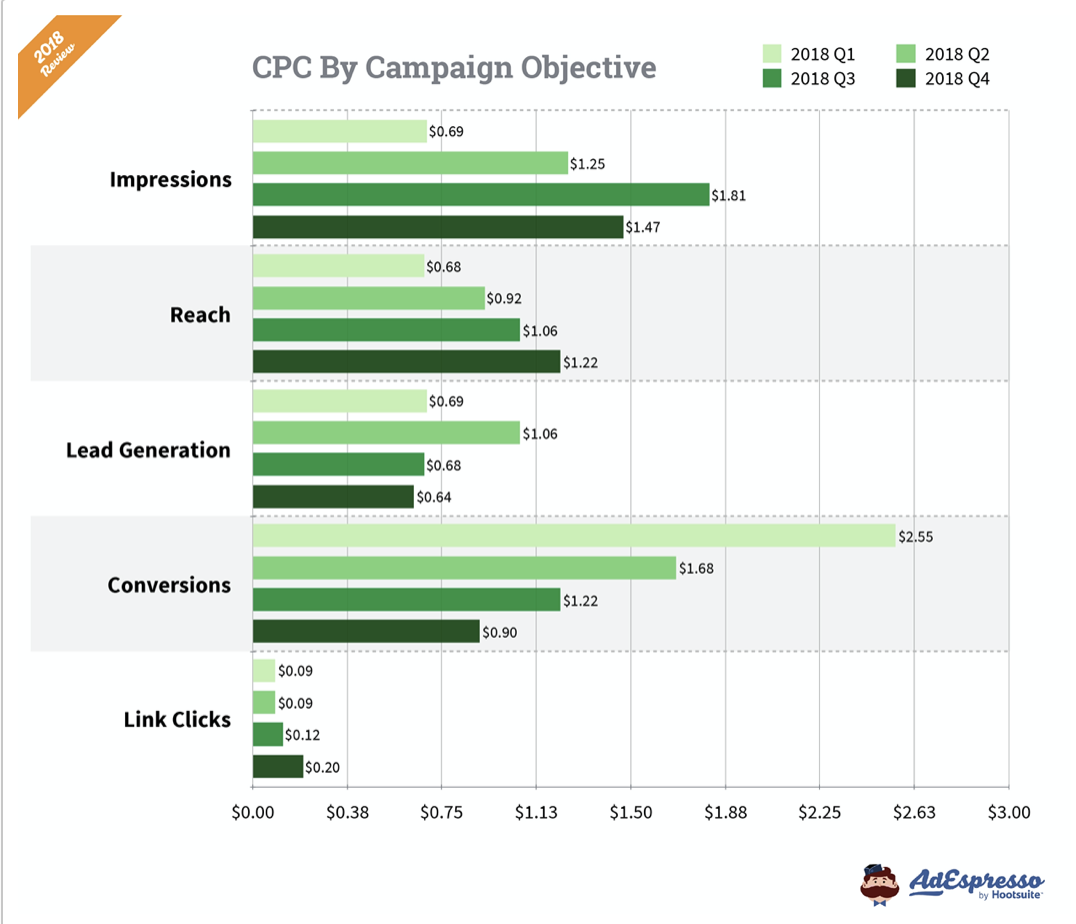
I’ve said it before and I’ll say it again: the best marketing is marketing that’s agile.
Although you don’t want to blow your budget, it’s good to assess every quarter and biannually to see what (if anything) needs to be changed.
3) Forgetting to Allocate Money for Tests (Including Failed Tests)
Split testing (also known as A/B testing) is essential in marketing. There are so many factors that can determine or influence success that you need to test them to find out which ones actually work for your brand.
You need to account for these tests in your marketing budget, and it’s also important to account for the fact that not all campaigns will be a success. Some won’t get the results you want, and sometimes this means the revenue you get as a result doesn’t quite cover the investment you put in.
If you’re trying out new strategies or platforms, you can start slow, making sure that they’re working in your favor. Give them enough time to see the impact (for PPC campaigns, this can be around two weeks, but for others like social media or content marketing, it can take up to three months, if not more) before you pull the plug, but assess carefully.
Learn from the Best! –> What Amazon’s Marketing Strategy Can Teach SMB Owners
4) Going All in on One Platform
Sometimes, business owners will come to me, positive that all they need to do to promote their business is content marketing. And yet they haven’t optimized their site for SEO, even though what they really want is more site traffic.
In other cases, people will put their entire marketing budget’s funds into a single platform, like one major influencer campaign or going all in on Google Ads, only to find that the platform they chose didn’t work well for them.
Not all platforms work equally well for all businesses, so taking a big risk with all (or most) of your ad spend before testing isn’t a good idea. Instead, divide up your budget between at least a few platforms. Not only will this increase your chance of success, it will also give you more ways to connect with your target audience, and more touch points are always good.
Book My Free Marketing Consultation
Conclusion
If you’re looking at how to create a marketing budget and allocate your spend, take some time to think carefully about your business’s goals: where you are now and what you think is the best path to achieve your goals. Again, there’s not just one right answer here, so look at what your business can afford, what your current growth goals are, and make decisions accordingly. You can (and should!) always adapt as time goes on.
The post How to Determine a Marketing Budget for Your Brand in 2020 appeared first on Single Grain.
from Single Grain https://ift.tt/2HFNDWe

No comments:
Post a Comment